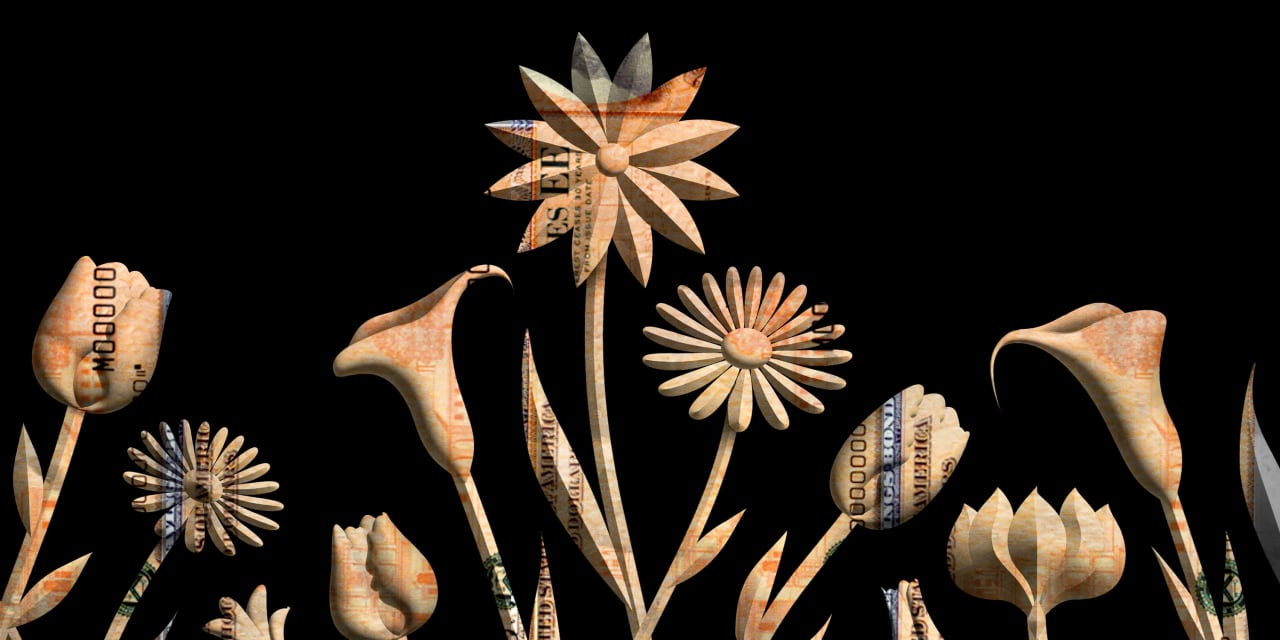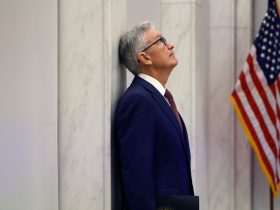Rarely in American history has it been this bad for bonds—and rarely has it been such an opportune time to buy.
The bond rout has been brutal. Supposedly ultrasafe Treasuries are on track to lose money for three consecutive years, declining 42% over that period. Other bonds, whether mortgage-backed securities or high-quality corporates, have also taken a beating, leaving investors with losses from what are supposed to provide ballast in a portfolio.
But consider what may come next: the end of the bond bear market. While long-term yields have spiked lately—pushing the 10-year Treasury to 4.9% from 4% in August—the Federal Reserve may be nearing the end of its campaign of interest-rate increases. Traders see only a 25% chance of another rate hike this year, possibly at the Fed’s meeting in December. Hedge fund manager Bill Ackman, a prominent bond bear, recently closed out his bets against Treasuries.
What’s more, continued geopolitical unrest or signs of a recession could restore the core market—government-backed debt and high-grade corporate bonds—to its position as a haven, a role it had abdicated in recent years. Since starting yields are higher, there is more cushion against losses, including interest income. And with rates stabilizing, bonds could start to play a positive role once again.
“It’s been a rough journey to a much better environment,” says Dan Ivascyn, chief investment officer at bond firm Pimco, which manages $1.74 trillion in assets. “We’re much more optimistic at this point going forward.”
The bull case starts with the fact that today’s entry point is the best in years. Yields across the Treasury market, at about 5%, are the highest since 2007. Investment-grade corporate bonds pay an average of 6.3%, a yield not seen since mid-2009. For someone in the 24% tax bracket, a 30-year municipal with a triple-A rating yields 6.1% when its tax advantage is included. (Although junk bonds average 9%, their “spread” over Treasuries is fairly narrow, indicating they aren’t cheap.)
As bond prices decline, their yields climb. An end to the bear market would send prices higher and yields lower.
Higher yields can solve a lot of problems. If inflation were still running at 9%, the income generated by bonds would be of scant use as higher prices would wipe out purchasing power; even 5% inflation would make it a wash. Inflation, though, isn’t the worry it was just a short while ago.
Treasury inflation-protected securities, or TIPS, maturing in both five and 10 years are pricing in inflation of 2.5%, implying that expectations are well anchored. At those levels, Treasuries are generating yields of 2.5% after inflation, the first time “real yields” have been meaningfully positive in over a decade.
“The real rate is so attractive that you don’t need to venture very far out on the curve and your yield will work for you,” says Rick Rieder, chief investment officer of global fixed income at
BlackRock
(ticker: BLK).
A yield cushion, especially in corporate credit, is now a bulwark against rates rising even higher. At over 6%, a basket of investment-grade corporate bonds maturing in one to five years could withstand a 3.25 percentage point increase in yields and still generate a positive one-year return, according to Parametric, an asset manager owned by
Morgan Stanley
(MS).
There’s even a chance that bonds get back to acting as shock absorbers, dampening volatility in a portfolio. That hasn’t been the case recently, as bond and stock prices have tended to move in the same direction—lower—as the Fed raised interest rates. That positive correlation between the two asset classes turned bonds from ballast to wrecking balls in portfolios with a mix of 60% in stocks and 40% in bonds, especially as the volatility of the
30-year Treasury
rose to levels consistent with the
S&P 500 index,
according to BlackRock’s Rieder.
Bonds, though, could offset stock losses again if investors stopped worrying about rising rates and started fretting about a recession. In that case, equities may be the first to take a hit, while Treasury prices would get a bump if the Fed pivoted from fighting inflation to supporting the economy.
There’s also a case for significant gains with far less downside risk, based on “bond math.” The 30-year Treasuries would gain nearly 13% over 12 months with a 0.5-point drop in yields, based on current levels, but the bonds would lose less than 3%, including interest, if rates rose by a half-point.
The upside case may be one reason investors seem so bullish on long-bonds: The
iShares 20+ Year Treasury Bond
exchange-traded fund (TLT) has raked in $11.8 billion of net inflows over the past six months, according to VettaFi.
It isn’t just long-term bonds that would benefit. Once the Fed does pause, the stage could be set for strong returns across the curve, according to J.P. Morgan’s fixed-income strategists. Over the past eight Fed tightening cycles, bond yields were down by a full percentage point, on average, after the final hike. That happened “irrespective of whether a recession or soft landing followed,” they wrote in a recent note.
Investors certainly have reason to be wary. Even during the 1970s, long-term Treasuries never strung together a losing streak like the current one. By some measures, the last comparable rout occurred in the late 1780s, when George Washington was inaugurated in white silk stockings, steel-hilted sword by his side. Back then, the fledgling U.S. government was debating whether to assume state debts, and how to pay for them, a situation that could have left bonds issued by government entities worthless. Such was the existential crisis that investors faced.
Today, of course, the Treasury can simply print money or issue more debt to make payments. But a combination of the Fed’s interest-rate increases and fears of entrenched inflation have caused bond prices to tumble.
Worse still, the losses have come in tandem with a drop in stocks, causing the classic 60/40 portfolio of stocks and bonds to lose 16% in 2022, its weakest showing since the global financial crisis of 2008-09. With bonds dragging down returns again this year, it’s enough to make investors think twice about whether bonds are even worth owning—particularly with money-market funds yielding 5% and giving bonds plenty of competition.
One persistent worry is that while inflation has been trending lower, it may turn out to be stickier than hoped. Stickier inflation could arise from forces like spending on decarbonization, reshoring of manufacturing, and increased military spending, according to Duke University finance professor and Research Affiliates director Campbell Harvey. At the same time, Federal deficits continue to grow, while interest on the debt could soon hit $1 trillion a year. That would make it the largest source of federal spending after Social Security and health benefits—and harder to manage.
The backdrop is complicated enough that active managers may be in a good spot to beat the indexes. Bond returns are typically based on two factors: duration and credit risks. The major indexes—and the funds that track them—are dominated by Treasuries and other government-backed debt. In the Bloomberg U.S. Aggregate Bond Index, Treasuries and agency-backed mortgage securities constitute nearly 71% of the market, swamping the impact of corporate credit on returns.
That makes the major indexes essentially bets on “duration,” or interest-rate sensitivity (since government-backed debt isn’t considered to have credit risk). For instance, the
iShares Core U.S. Aggregate Bond
exchange-traded fund (AGG) has a duration of nearly six years with a yield of 4.8%. If rates rose by a percentage point over a 12-month period, the ETF’s total return would be negative 0.5%.
The high weighting in government debt has crushed net asset values, or share prices, for broad-market index funds. The AGG ETF now trades below its share price of 15 years ago. The
Vanguard Total Bond Market
ETF (BND) is also below its net asset value from October 2008, though both ETFs have eked out positive annualized returns through interest income over those periods.
Indexes tend to track the entire market with no thought of macro factors. Active managers can toggle between duration and credit risk, while also reducing exposure to each. “The way indexes are set up, they’re structurally going to have a lot of rate risk,” says Michael Contopoulos, fixed-income strategist at Richard Bernstein Advisors. “Active today is what you need, but it has to be truly active where the portfolio changes in a meaningful way.”
A standout among mutual funds—without much rate sensitivity—is
Pimco Low Duration Income
(PFIAX). The fund invests mainly in core sectors like government debt, mortgages, and investment-grade corporates—averaging an A+ credit rating, according to Morningstar—and it sticks with short-term debt, keeping its duration at just 2.2 years.
That profile helped the fund hold up reasonably well amid rising rates. The fund is up 2.6% this year and 0.8% annualized over the past three years, returning much more than the broader market. Over the past decade, the fund has beaten 98% of peers, according to Morningstar.
Ivascyn, who co-manages the portfolio, is emphasizing higher credit quality and has cut exposure to junk bonds as spreads tightened. He likes nonagency mortgage securities based on home loans that were mainly issued 15 years ago at fixed rates, providing plenty of home-equity cushions against defaults. Those types of bonds aren’t in the AGG, he points out, and trade at big discounts due to fears about a housing downturn.
BlackRock Strategic Income Opportunities
(BASIX), earning a Gold rating from Morningstar, is another alternative. Aiming for above-average total returns, its portfolio includes foreign markets, U.S. debt, corporate credit, and derivatives, and it delivers a 4.9% yield with a low duration of 3.5 years. Lead manager Rieder says he has been buying high-quality short-term commercial paper issued by banks and industrial companies, which yield more than 6%, and AAA-rated collateralized loan obligations, or CLOs, which yield 6.5% and have scant credit risk or rate sensitivity. One knock on the fund: Its high expense ratio of 0.99%.
The
BlackRock Flexible Income
ETF (BINC) is a tactical high-yield fund with a goal of lower volatility than Strategic Income. It’s much cheaper at a 0.4% annual cost. The ETF, which yields 5.9% and launched in May, is up 0.3% since inception.
Another mutual fund to consider is
Osterweis Strategic Income
(OSTIX). Paying out 7.2%, it combines high yield and low duration. Its 150 holdings consist mainly of junk bonds and similar securities with an effective duration of 2.3 years. Top holdings include debt issued by
American Airlines Group
(AAL),
Goodyear Tire & Rubber
(GT), and
Starwood Property Trust
(STWD).
Co-manager Craig Manchuck says he’s avoiding low-rated debt issued by companies owned by private-equity firms. Instead, he’s focusing on higher-quality BB-rated or BBB-rated bonds maturing in one to two years. “Coupons are getting higher and dollar prices lower,” he says. Cash in the fund is also helping to lift returns, he notes, since it now yields about 5%.
Perhaps the biggest competition for bond funds is cash and T-bills. Retail money-market funds yield an average 4.9%, while Vanguard Federal Money Market (VMFXX), one of the lowest-cost funds, yields 5.3%. Those yields are comparable to short-term Treasury bills, which largely track the federal-funds rate and prospects for additional rate hikes. A six-month T-bill held to maturity yields 5.56% while one-year bills yield 5.45%.
The knock on cash and T-bills is that yields will fall fast if the Fed cuts rates next year. Investors could miss out on a big bond rally and would have to reinvest at lower market rates. It’s an opportunity cost—the risk of giving up capital gains if there’s a geopolitical shock or the Fed cuts. Do-it-yourself investors, though, could “ladder” the bonds, buying several at different maturities on TreasuryDirect.gov, at a bank, or in a brokerage account, and reinvesting the cash when they come due.
No matter how you do it, a 5% cash yield may be a bird in the hand worth taking.
Write to Daren Fonda at [email protected]
Read the full article here









Leave a Reply